brake GMC SIERRA 1996 Owners Manual
[x] Cancel search | Manufacturer: GMC, Model Year: 1996, Model line: SIERRA, Model: GMC SIERRA 1996Pages: 404, PDF Size: 21.57 MB
Page 7 of 404

Vehicle Symbols
These are some of the symbols you may find on your vehicle.
For example,
these symbols
are used on an
original battery:
POSSIBLE A
CAUTION
INJURY
PROTECT EYES BY
SHIELDING
CAUSTIC
ACID COULD BATTERY
CAUSE
BURNS
These symbols
are important
for you and
your passengers
whenever your
vehicle is
driven:
DOOR LOCK
UNLOCK
FASTEN SEAT
BELTS
These symbols
have
to do with
your lights:
SIGNALS e e3
TURN
WARNING
A
HAZARD
FLASHER
These symbols are
on some of
your controls:
WINDSHIELD
DEFROSTER
These symbols are used on
warning and
indicator lights:
COOLANT
TEMP
-
CHARGING I-1
BAllERY
SYSTEM
BRAKE
(0)
Here are some
other symbols
you may see:
FUSE
LIGHTER
AVOID
SPARKS
OR
FLAMES
SPARK
OR ,\I/,
COULD FLAME
EXPLODE BATTERY POWER
WINDOW RUNNING
0
DAYTIME -
LAMPS '*'
FOG LAMPS # 0
VENTILATING
FAN
1
-3
COOLANT a
ENGINE OIL e,
PRESSURE HORN
)tr
SPEAKER v
FUEL B
V
ProCarManuals.com
Page 70 of 404
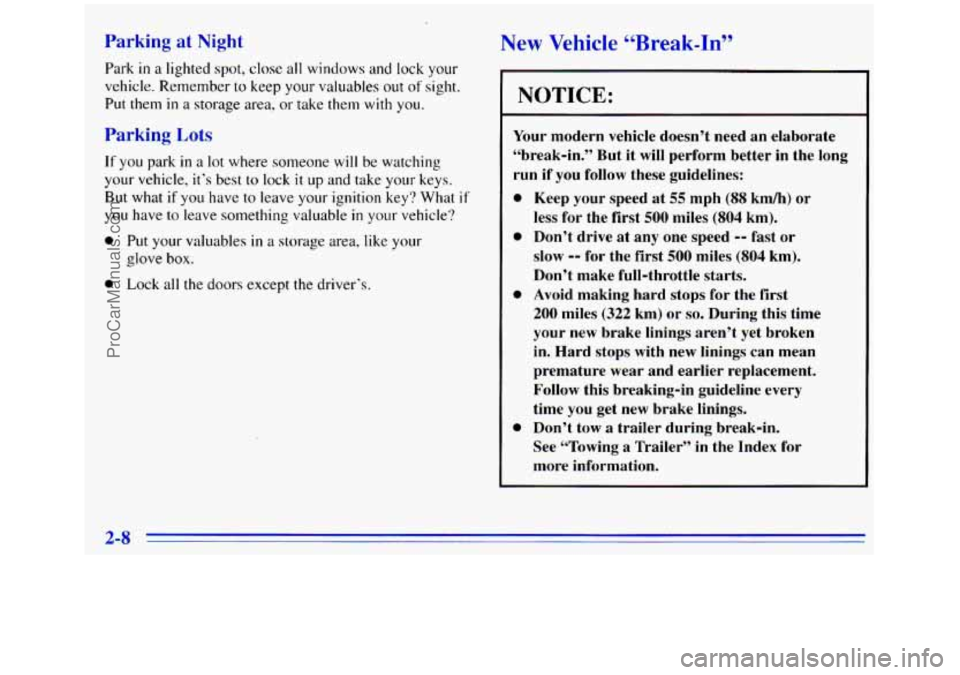
Parking at Night New Vehicle “Break-In”
Park in a lighted spot, close all windows and lock your
vehicle. Remember
to keep your valuables out of sight.
Put
them in a storage area, or take them with you.
Parking Lots
If you park in a lot where someone will be watching
your vehicle, it’s best
to lock it up and take your keys.
But what if you have to leave your ignition key? What if
you have to leave something valuable in your vehicle?
0 Put your valuables in a storage area, like your
glove
box.
0 Lock all the doors except the driver‘s.
NOTICE:
Your modern vehicle doesn’t need an elaborate
“break-in.” But it
will perform better in the long
run
if you follow these guidelines:
0
0
0
0
Keep your speed at 55 mph (88 km/h) or
less for the first
500 miles (804 km).
Don’t drive at any one speed
-- fast or
slow
-- for the first 500 miles (804 km).
Don’t make full-throttle starts.
Avoid making hard stops for the
first
200 miles (322 km) or so. During this time
your new brake linings aren’t yet broken
in. Hard stops with new linings can mean
premature wear and earlier replacement.
Follow this breaking-in guideline every
time you get new brake linings.
Don’t tow a trailer during break-in.
See “Towing
a Trailer” in the Index for
more information.
2-8
ProCarManuals.com
Page 76 of 404

PARK (P): This locks your rear wheels. It’s the best
position
to use when you start your engine because your
vehicle can’t move
easily.
It is dangerous to get out of your vehicle if the
shift lever is not fully in PARK
(P) with the
parking brake firmly set. Your vehicle can roll.
Don’t leave
your vehicle when the engine is
running unless you have to.
If you have left the
engine running, the vehicle can move suddenly.
You or others could be injured. To be sure your
vehicle won’t move, even when you’re on fairly
level ground,
always set your parking brake and
move the shift lever to
PARK (P).
I
CAUTION: (Continued)
-
if’ you have four-wheel drive, your vehicle
will be free to roll -- even if your shift lever
is in PARK
(P) -- if your transfer case is in
NEUTRAL (N). So, be sure the transfer case is
in a drive gear, two-wheel high
(2H) or four-wheel
high
(4H) or four-wheel low (4L) -- not in
NEUTRAL
(N). See “Shifting Into PARK (P)” in
the Index. If you’re pulling
a trailer, see “Towing a
Trailer” in the Index.
2-14
ProCarManuals.com
Page 77 of 404
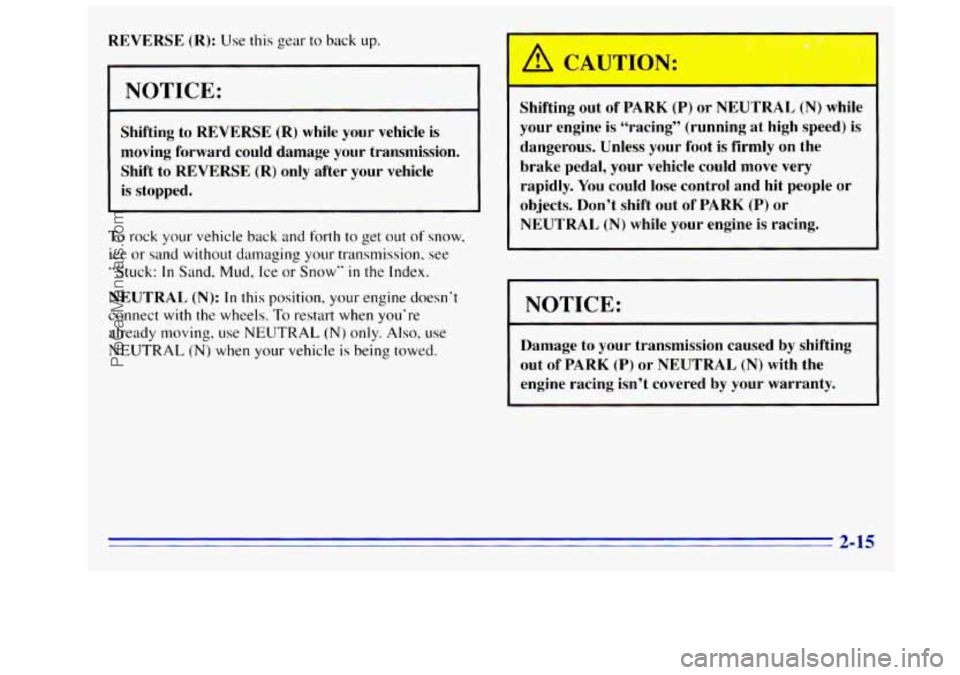
REVERSE (R): Use this gear to back up.
NOTICE:
Shifting to REVERSE (R) while your vehicle is
moving forward could damage your transmission.
Shift to
REVERSE (R) only after your vehicle
is stopped.
I rock your vehicle back and forth to get out of snow.
ice or sand without damaging your transmission, see
“Stuck:
In Sand. Mud, Ice or Snow” in the Index.
NEUTRAL (N): In this position, your engine doesn’t
connect with the wheels.
To restart when you’re
already moving, use
NEUTRAL (N) only. Also, use
NEUTRAL (N) when your vehicle is being towed.
I Shifting out of PARK (P) or NEUTRAL (N) while
your engine
is “racing” (running at high speed) is
dangerous. Unless your
foot is firmly on the
brake pedal, your vehicle could move very
rapidly. You could lose control and hit people
or
objects. Don’t shift out of PARK (P) or
NEUTRAL (N) while your engine is racing.
I NOTICE:
Damage to your transmission caused by shifting
out
of PARK (P) or NEUTRAL (N) with the
engine racing isn’t covered by your warranty.
2-15
ProCarManuals.com
Page 78 of 404
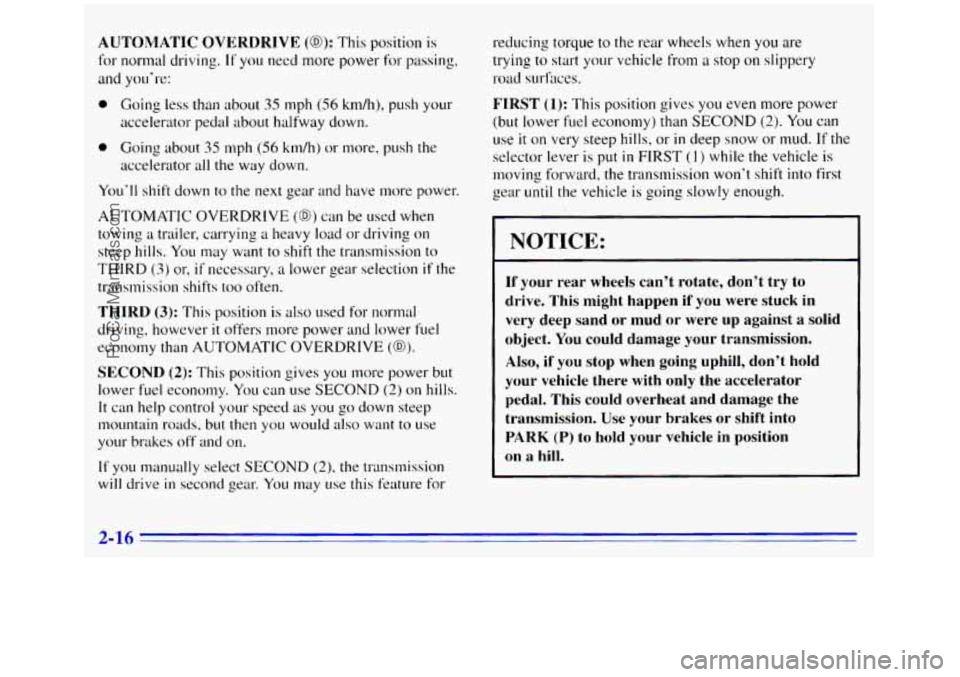
AUTOMATIC OVERDRIVE (0): This position is
for normal driving. If you need more power for passing,
and you’re:
0 Going less than about 35 mph (56 km/h), push your
accelerator pedal about halfway down.
accelerator all the way down.
0 Going about 35 mph (56 kdhj or more, push the
You’ll shift down to the next gear and have more power.
AUTOMATIC OVERDRIVE
(GO) can be used when
towing a trailer, carrying
a heavy load or driving on
steep hills. You may want to shift the transmission to
THIRD
(3) or, if necessary, a lower gear selection if the
transmission shifts
too often.
THIRD (3): This position is also used for normal
driving, however
it offers more power and lower fuel
economy than
AUTOMATIC OVERDRIVE (68).
SECOND (2): This position gives you more power but
lower fuel economy. You can use
SECOND (2) on hills.
It can help control your speed as you go down steep
mountain roads, but
then you would also want to use
your brakes off and on.
If you manually select SECOND (2), the transmission
will drive in second gear. You may use this feature for reducing torque to
the rear wheels when
you are
trying to start your vehicle
from a stop on slippery
road surfaces.
FIRST (1): This position gives you even more power
(but lower fuel economy) than
SECOND (2). You can
use it on very steep hills, or in deep snow or mud. If the
selector lever is put
in FIRST (1) while the vehicle is
moving forward, the transmission won’t shift into first
gear
until the vehicle is going slowly enough.
NOTICE:
If your rear wheels can’t rotate, don’t try to
drive. This might happen if you were stuck in
very deep sand or mud or were
up against a solid
object. You could damage your transmission.
Also, if you stop when going uphill, don’t hold
your vehicle there with only the accelerator pedal. This could overheat and damage the
transmission. Use your brakes
or shift into
PARK
(P) to hold your vehicle in position
on a hill.
2-16
ProCarManuals.com
Page 79 of 404
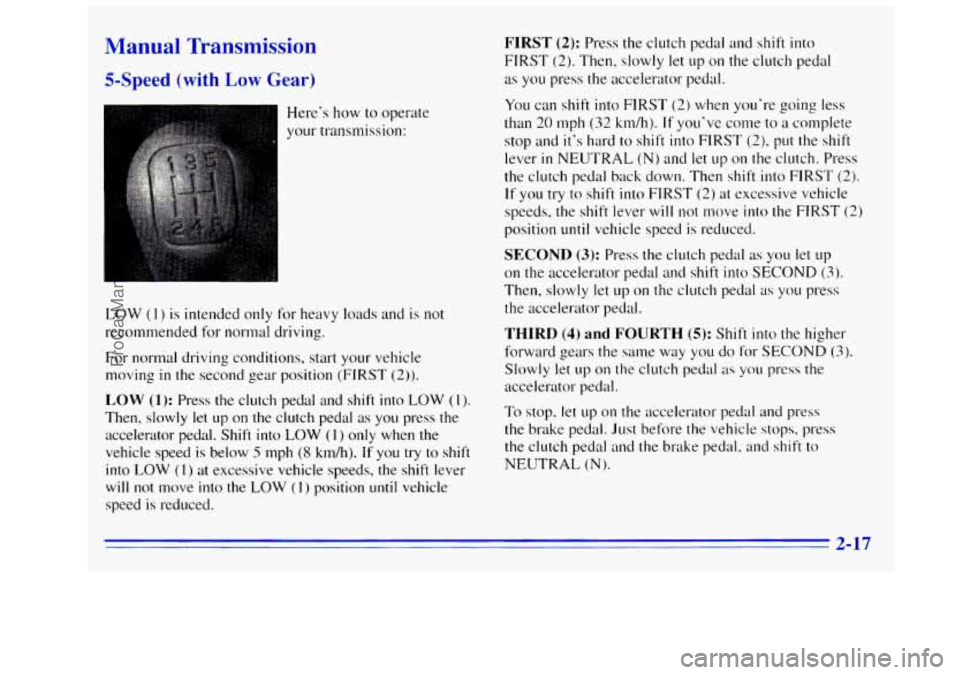
Manual Transmission
5-Speed (with Low Gear)
Here's how to operate
your transmission:
LOW
(1 ) is intended only for heavy loads and is not
recommended for normal driving.
For normal driving conditions, start
your vehicle
moving
in the second gear position (FIRST (2)).
LOW (1): Press the clutch pedal and shift into LOW (1 ).
Then, slowly let up on the clutch pedal as you press the
accelerator pedal. Shift into LOW
(1) only when the
vehicle speed is below
5 tnph (8 kmh). If you try to shift
into LOW (1) at excessive vehicle speeds, the shift lever
will not move
into the LOW (1) position until vehicle
speed is reduced.
FIRST (2): Press the clutch pedal and shift into
FIRST (2). Then. slowly let up on the clutch pedal
as you press the accelerator pedal.
You can shift into
FIRST (2) when you're going less
than
20 mph (32 kdh). If you've come to a complete
stop and it's hard to shift into
FIRST (2), put the shift
lever
in NEUTRAL (N) and let up on the clutch. Press
the clutch pedal back down. Then
shift into FIRST (2).
If you try to shift into FIRST (2) at excessive vehicle
speeds, the shift lever will not move
into the FIRST (2)
position until vehicle speed is reduced.
SECOND (3): Press the clutch pedal as you let up
on the accelerator pedal and shift into SECOND (3).
Then, slowly let up on the clutch pedal as YOLI press
the accelerator pedal.
THIRD (4) and FOURTH (5): Shift into the higher
forward gears the same way you do for
SECOND (3).
Slowly let up on the clutch pedal as you press the
accelerator pedal.
To stop. let
up on the accelerator pedal and press
the brake pedal. Just before the vehicle stops, press
the clutch pedal and the brake pedal, and shift to
NEUTRAL
(N).
2-17
ProCarManuals.com
Page 80 of 404
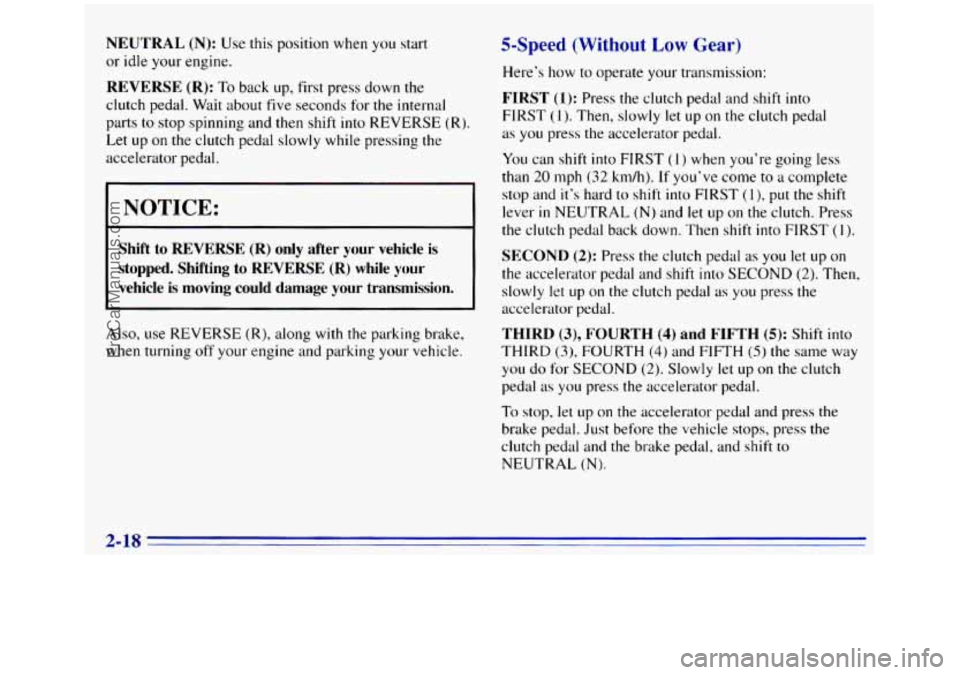
NEUTRAL (N): Use this position when YOLI start
or idle your engine.
REVERSE (R): To back up, first press down the
clutch pedal. Wait about five seconds for the internal
parts
to stop spinning and then shift into REVERSE (R).
Let up on the clutch pedal slowly while pressing the
accelerator pedal.
NOTICE:
Shift to REVERSE (R) only after your vehicle is
stopped. Shifting
to REVERSE (R) while your
vehicle is moving could damage your transmission.
Also, use REVERSE (R), along with the parking brake,
when turning off your engine and parking your vehicle.
5-Speed (Without Low Gear)
Here’s how to operate your transmission:
FIRST (1): Press the clutch pedal and shift into
FIRST
(I ). Then, slowly let up on the clutch pedal
as you press the accelerator pedal.
You can shift into FIRST
( 1 ) when you’re going less
than
20 mph (32 km/h). If you’ve come to a complete
stop and it’s hard to shift
into FIRST (l), put the shift
lever
in NEUTRAL (N) and let up on the clutch. Press
the clutch pedal back down. Then shift into FIRST
(1).
SECOND (2): Press the clutch pedal as you let up on
the accelerator pedal and shift
into SECOND (2). Then,
slowly let up on the clutch pedal as you press the
accelerator pedal.
THIRD (3), FOURTH (4) and FIFTH (5): Shift into
THIRD
(3), FOURTH (4) and FIFTH (5) the same way
you do for SECOND (2). Slowly let up on the clutch
pedal
as you press the accelerator pedal.
To stop, let up on the accelerator pedal and press the
brake pedal. Just before the vehicle stops, press the
clutch pedal and the brake pedal, and shift
to
NEUTRAL (N).
2-18
ProCarManuals.com
Page 81 of 404
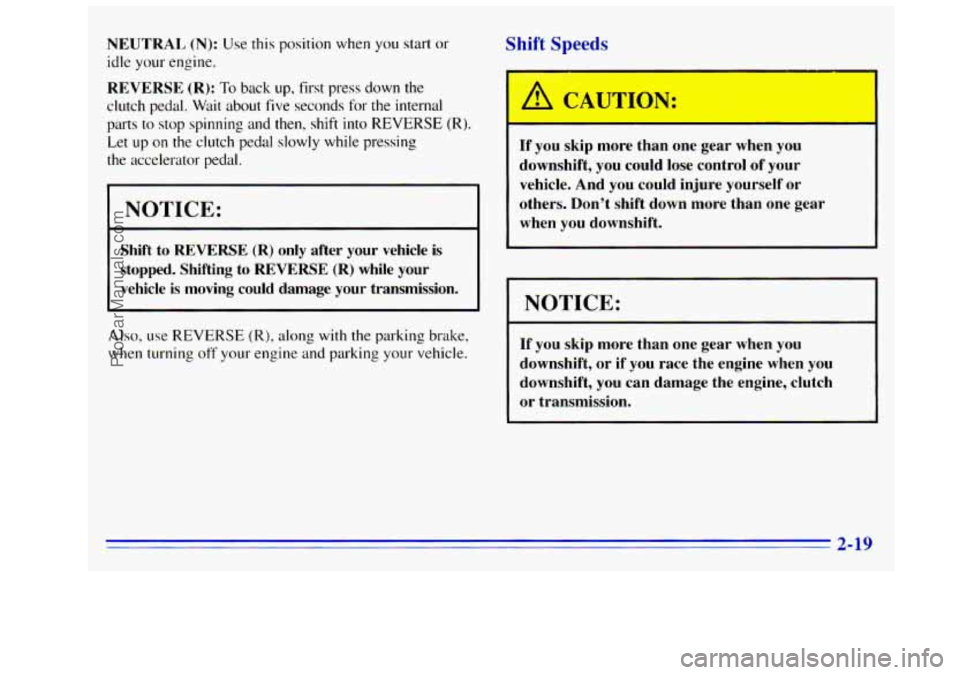
NEUTRAL (N): Use this position when you start or
idle your engine.
REVERSE (R): To back up, first press down the
clutch pedal.
Wait about five seconds for the internal
parts
to stop spinning and then, shift into REVERSE (R).
Let up on the clutch pedal slowly while pressing
the accelerator pedal.
.
NOTICE:
Shift to REVERSE (R) only after your vehicle is
stopped. Shifting to
REVERSE (R) while your
vehicle is moving could damage your transmission.
Also, use REVERSE (R), along with the parking brake,
when turning off
your engine and parking your vehicle.
Shift Speeds
A CAUTION:
If you skip more than one gear when you
downshift, you could lose control of your
vehicle. And you could injure yourself or
others. Don’t shift down more than one gear
when you downshift.
NOTICE:
If you skip more than one gear when you
downshift, or
if you race the engine when you
downshift, you can damage the engine, clutch
or transmission.
2-19
ProCarManuals.com
Page 87 of 404

Shifting from 4LO to 4HI or 2HI
To shift from 4LO to 4HI or 2H1, your vehicle must be
stopped or moving less than
3 mph (4.8 km/h) with the
transmission in NEUTRAL (N). The preferred method
for shifting
out of 4LO is to have your vehicle moving
1 to 2 mph (1.6 to 3.2 km/h). Press and release the 4HI
switch.
You must wait for the 4HI indicator light to stop
flashing and remain illuminated before shifting your
transmission
into gear.
If the 4HI switch is pressed when your vehicle is in
gear and/or moving, the 4HI indicator light will flash for
30 seconds but not complete the shift unless the vehicle
is moving slower than
3 mph (4.8 km/h) and the
transmission is in NEUTRAL (N).
Parking Brake
To set the parking brake, hold the regular brake pedal
down
with your right foot. Push down the parking brake
pedal with your left foot.
If the ignition is on, the brake system warning light will
come
on.
To release the parking brake, hold the regular brake
pedal down.
lull the lever, located
1st above the parking
rake pedal, marked
;RAKE RELEASE.
If the ignition is on when the parking brake is released,
the brake system warning light
will go off.
2-25
ProCarManuals.com
Page 88 of 404
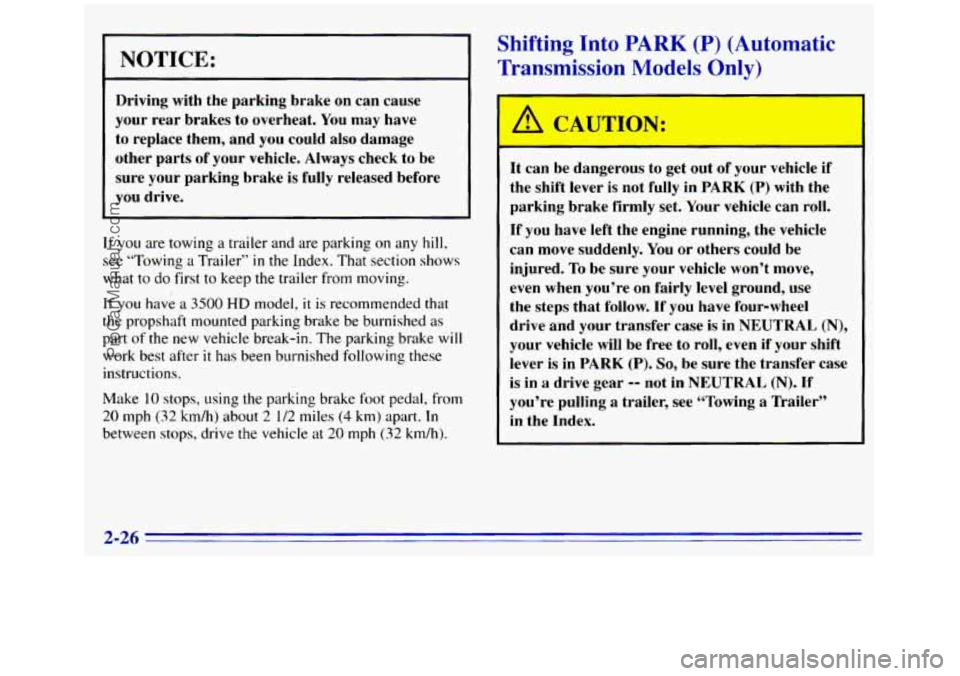
NOTICE:
Driving with the parking brake on can cause
your rear brakes to overheat.
You may have
to replace them, and you could also damage
other parts of your vehicle. Always check to be
sure your parking brake is fully released before
you drive.
If you are towing a trailer and are parking on any hill,
see “Towing a Trailer” in the Index. That section shows
what
to do first to keep the trailer from moving.
If you have a 3500 HD model, it is recommended that
the propshaft mounted parking brake be burnished as
part of the new vehicle break-in. The parking brake will
work best after it has been burnished following these
instructions.
Make
10 stops, using the parking brake foot pedal, from
20 mph (32 km/h) about 2 1/2 miles (4 km) apart. In
between stops, drive the vehicle at 20 mph (32 km/h).
Shifting Into PARK (P) (Automatic
Trawrission
Models Only)
It can be dangerous to get out of your vehicle if
the shift lever
is not fully in PARK (P) with the
parking brake firmly set. Your vehicle can
roll.
If you have left the engine running, the vehicle
can move suddenly. You or others could be
injured.
To be sure your vehicle won’t move,
even when you’re on fairly level ground, use
the steps that follow. If you have four-wheel
drive and your transfer case is in NEUTRAL
(N)?
your vehicle will be free to roll, even if your shift
lever
is in PARK (P). So, be sure the transfer case
is in
a drive gear -- not in NEUTRAL (N). If
you’re pulling a trailer, see “Towing a Trailer’’
in the Index.
2-26
ProCarManuals.com